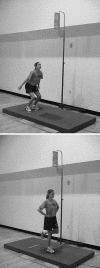Dynamic Stabilization Time After Isokinetic and Functional Fatigue
- PMID: 15496994
- PMCID: PMC522147
Dynamic Stabilization Time After Isokinetic and Functional Fatigue
Abstract
OBJECTIVE: To compare the effects of an isokinetic fatigue protocol and a functional fatigue protocol on time to stabilization (TTS), ground reaction force (GRF), and joint kinematics during a jump landing. DESIGN AND SETTING: Subjects were assessed on 2 occasions for TTS, GRF, and joint kinematics immediately before and after completing a fatigue protocol. One week separated the 2 sessions, and the order of fatigue protocols was randomly assigned and counterbalanced. SUBJECTS: Twenty healthy male (n = 8, age = 21.8 +/- 1.4 years, height = 180.6 +/- 7.6 cm, and mass = 74.1 +/- 13.0 kg) and female (n = 12, age = 22.2 +/- 2.1 years, height = 169.3 +/- 9.8 cm, and mass = 62.5 +/- 10.1 kg) subjects volunteered to participate. MEASUREMENTS: Subjects performed 2-legged jumps equivalent to 50% of maximum jump height, followed by a single-leg landing onto the center of a forceplate 70 cm from the starting position. Peak vertical GRF and vertical, medial-lateral, and anterior-posterior TTS were obtained from forceplate recordings. Maximum ankle dorsiflexion, knee-flexion, and knee-valgum angles were determined using 3-dimensional motion analysis. RESULTS: A 2-way analysis of variance with repeated measures revealed no significant differences when comparing TTS, GRF, and joint kinematics after isokinetic and functional fatigue protocols. CONCLUSIONS: No difference was noted between isokinetic and functional fatigue protocols relative to dynamic stability when landing from a jump.
Figures
Similar articles
-
The effect of fatigue on landing biomechanics in single-leg drop landings.Clin J Sport Med. 2010 Jul;20(4):286-92. doi: 10.1097/JSM.0b013e3181e8f7dc. Clin J Sport Med. 2010. PMID: 20606514
-
The effect of jump-landing directions on dynamic stability.J Appl Biomech. 2013 Oct;29(5):634-8. doi: 10.1123/jab.29.5.634. Epub 2012 Nov 21. J Appl Biomech. 2013. PMID: 23182979
-
Agonist versus antagonist muscle fatigue effects on thigh muscle activity and vertical ground reaction during drop landing.J Electromyogr Kinesiol. 2009 Feb;19(1):55-64. doi: 10.1016/j.jelekin.2007.08.002. Epub 2007 Sep 20. J Electromyogr Kinesiol. 2009. PMID: 17888681
-
Detection of dynamic stability deficits in subjects with functional ankle instability.Med Sci Sports Exerc. 2005 Feb;37(2):169-75. doi: 10.1249/01.mss.0000149887.84238.6c. Med Sci Sports Exerc. 2005. PMID: 15692310
-
Ankle bracing, fatigue, and time to stabilization in collegiate volleyball athletes.J Athl Train. 2008 Apr-Jun;43(2):164-71. doi: 10.4085/1062-6050-43.2.164. J Athl Train. 2008. PMID: 18345341 Free PMC article.
Cited by
-
Dynamic Postural Stability in Active, Adolescent Males Following Repeated Bouts of Aerobic Exercise in Hot and Temperate Environments: A Pilot Study.Mil Med. 2020 Jan 7;185(Suppl 1):368-375. doi: 10.1093/milmed/usz286. Mil Med. 2020. PMID: 32074301 Free PMC article.
-
Effects of Patellofemoral Pain Syndrome on Changes in Dynamic Postural Stability during Landing in Adult Women.Appl Bionics Biomech. 2022 May 10;2022:7452229. doi: 10.1155/2022/7452229. eCollection 2022. Appl Bionics Biomech. 2022. PMID: 35592870 Free PMC article.
-
Temporal Kinematic Differences between Forward and Backward Jump-Landing.Int J Environ Res Public Health. 2020 Sep 13;17(18):6669. doi: 10.3390/ijerph17186669. Int J Environ Res Public Health. 2020. PMID: 32933208 Free PMC article.
-
A high-intensity, intermittent exercise protocol and dynamic postural control in men and women.J Athl Train. 2015 Apr;50(4):392-9. doi: 10.4085/1062-6050-49.6.08. Epub 2015 Feb 17. J Athl Train. 2015. PMID: 25689420 Free PMC article.
-
Effects of exercise continued until anaerobic threshold on balance performance in male basketball players.J Hum Kinet. 2012 Jun;33:73-9. doi: 10.2478/v10078-012-0046-0. Epub 2012 Jul 4. J Hum Kinet. 2012. PMID: 23485960 Free PMC article.
References
-
- Ekstrand J, Gillquist J. Soccer injuries and their mechanisms: a prospective study. Med Sci Sports Exerc. 1983;15:267–270. - PubMed
-
- Goodwin-Gerberich SG, Luhmann S, Finke C, Priest JD, Beard BJ. Analysis of severe injuries associated with volleyball activities. Physician Sportsmed. 1982;15(8):75–79.
-
- Gray J, Taunton JE, McKenzie DC, Clement DB, McConkey JP, Davidson RG. A survey of injuries to the anterior cruciate ligament of the knee in female basketball players. Int J Sports Med. 1985;6:314–316. - PubMed
-
- Devita P, Skelly WA. Effect of landing stiffness on joint kinetics and energetics in the lower extremity. Med Sci Sports Exerc. 1992;24:108–115. - PubMed
LinkOut - more resources
Full Text Sources


